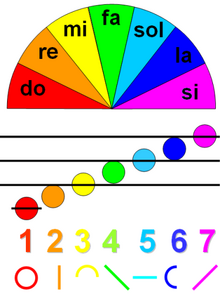Solresol
The solresol is an artificial language designed by the Frenchman François Sudre starting in 1817. The solresol achieved a brief popularity, peaking with the publication Grammaire du Solrésol, by Boleslas Gajewski, in 1902. It is based on musical notes, so it can be whistled or played on a musical instrument, as well as spoken. It only has seven minimum units: the seven basic notes. This scarcity of phonemes, however, implies great versatility when it comes to transmitting the language by means other than the conventional one. Thus, for example, the solresol can be written in various ways following established codings: on a stave, with the numbers from 1 to 7, with the initials of the notes (d, r, m, f, so, l, s), with a stenographic alphabet of seven simple figures, with the seven colors of the rainbow. Various other non-graphical systems like gestures, and tap codes, for example, can be used.
As with languages such as ro, words are divided into categories of meaning, based on the first syllable or musical note. Words beginning with 'sun' have meanings related to the arts and sciences; those beginning with 'solsol', disease and medicine (for example solresol is "language", while solsolredo is &# 34;migraine").
A unique feature of solresol is that some antonyms are obtained by saying the syllables, or notes, backwards. Thus, fala means "good" or "tasty", while lafa is "bad".
After a relatively ephemeral success, it fell into oblivion in the face of more successful languages such as Esperanto. Despite this, there is still a small community of solresol enthusiasts[citation needed] scattered around the world, and more capable of communicating with each other via the Internet than usual. they had been in the past.
Contenido relacionado
Negation (grammar)
Talk about moon
Kweyol language

